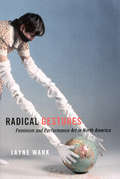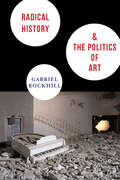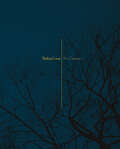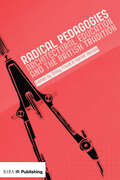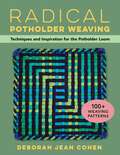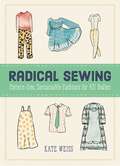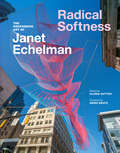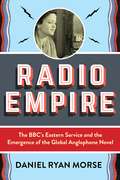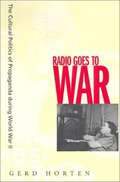- Table View
- List View
Radical Dreams: Surrealism, Counterculture, Resistance (Refiguring Modernism #35)
by Elliott H. King and Abigail SusikSurrealism is widely thought of as an artistic movement that flourished in Europe between the two world wars. However, during the 1960s, ’70s, and ’80s, diverse radical affinity groups, underground subcultures, and student protest movements proclaimed their connections to surrealism. Radical Dreams argues that surrealism was more than an avant-garde art movement; it was a living current of anti-authoritarian resistance.Featuring perspectives from scholars across the humanities and, distinctively, from contemporary surrealist practitioners, this volume examines surrealism’s role in postwar oppositional cultures. It demonstrates how surrealism’s committed engagement extends beyond the parameters of an artistic style or historical period, with chapters devoted to Afrosurrealism, Ted Joans, punk, the Situationist International, the student protests of May ’68, and other topics. Privileging interdisciplinary, transhistorical, and material culture approaches, contributors address surrealism’s interaction with New Left politics, protest movements, the sexual revolution, psychedelia, and other subcultural trends around the globe. A revelatory work, Radical Dreams definitively shows that the surrealist movement was synonymous with cultural and political radicalism. It will be especially valuable to those interested in the avant-garde, contemporary art, and radical social movements.In addition to the editors, the contributors to this volume include Mikkel Bolt Rasmussen, Jonathan P. Eburne, David Hopkins, Claire Howard, Michael Löwy, Alyce Mahon, Gavin Parkinson, Grégory Pierrot, Penelope Rosemont, Ron Sakolsky, Marie Arleth Skov, Ryan Standfest, and Sandra Zalman.
Radical Dreams: Surrealism, Counterculture, Resistance (Refiguring Modernism)
by Elliott H. King and Abigail SusikSurrealism is widely thought of as an artistic movement that flourished in Europe between the two world wars. However, during the 1960s, ’70s, and ’80s, diverse radical affinity groups, underground subcultures, and student protest movements proclaimed their connections to surrealism. Radical Dreams argues that surrealism was more than an avant-garde art movement; it was a living current of anti-authoritarian resistance.Featuring perspectives from scholars across the humanities and, distinctively, from contemporary surrealist practitioners, this volume examines surrealism’s role in postwar oppositional cultures. It demonstrates how surrealism’s committed engagement extends beyond the parameters of an artistic style or historical period, with chapters devoted to Afrosurrealism, Ted Joans, punk, the Situationist International, the student protests of May ’68, and other topics. Privileging interdisciplinary, transhistorical, and material culture approaches, contributors address surrealism’s interaction with New Left politics, protest movements, the sexual revolution, psychedelia, and other subcultural trends around the globe. A revelatory work, Radical Dreams definitively shows that the surrealist movement was synonymous with cultural and political radicalism. It will be especially valuable to those interested in the avant-garde, contemporary art, and radical social movements.In addition to the editors, the contributors to this volume include Mikkel Bolt Rasmussen, Jonathan P. Eburne, David Hopkins, Claire Howard, Michael Löwy, Alyce Mahon, Gavin Parkinson, Grégory Pierrot, Penelope Rosemont, Ron Sakolsky, Marie Arleth Skov, Ryan Standfest, and Sandra Zalman.
Radical Functionalism: A Social Architecture for Mexico (Routledge Research in Architecture)
by Luis E. CarranzaRadical Functionalism: A Social Architecture for Mexico provides a complex and nuanced understanding of the functionalist architecture developed in Mexico during the 1930s. It carefully re-reads the central texts and projects of its main advocates to show how their theories responded to the socially and culturally charged Mexican context. These, such as architects Juan Legarreta, Juan O’Gorman, the Union of Socialist Architects, and Manuel Amábilis, were part of broader explorations to develop a modern, national architecture intended to address the needs of the Mexican working classes. Through their refunctioning of functionalism, these radical thinkers showed how architecture could stand at the precipice of Mexico's impending modernization and respond to its impending changes. The book examines their engagement and negotiation with foreign influences, issues of gender and class, and the separation between art and architecture. Functionalist practices are presented as contradictory and experimental, as challenging the role of architecture in the transformation of society, and as intimately linked to art and local culture in the development of new forms of architecture for Mexico, including the "vernacularization" of functionalism itself. Uniquely including translations of two manifesto-like texts by O’Gorman expressing the polemical nature of their investigations, Radical Functionalism: A Social Architecture for Mexico will be a useful reference for scholars, researchers and students interested in the history of architectural movements.
Radical Gestures
by Jayne WarkWark brings together a wide range of artists, including Lisa Steele, Martha Rosler, Lynda Benglis, Gillian Collyer, Margaret Dragu, and Sylvie Tourangeau, and provides detailed readings and viewings of individual pieces, many of which have not been studied in detail before. She reassesses assumptions about the generational and thematic characteristics of feminist art, placing feminist performance within the wider context of minimalism, conceptualism, land art, and happenings
Radical Gestures: Feminism and Performance Art in North America
by Jayne WarkWark brings together a wide range of artists, including Lisa Steele, Martha Rosler, Lynda Benglis, Gillian Collyer, Margaret Dragu, and Sylvie Tourangeau, and provides detailed readings and viewings of individual pieces, many of which have not been studied in detail before. She reassesses assumptions about the generational and thematic characteristics of feminist art, placing feminist performance within the wider context of minimalism, conceptualism, land art, and happenings
Radical History and the Politics of Art
by Gabriel RockhillGabriel Rockhill opens new space for rethinking the relationship between art and politics. Rather than understanding the two spheres as separated by an insurmountable divide or linked by a privileged bridge, Rockhill demonstrates that art and politics are not fixed entities with a singular relation but rather dynamically negotiated, sociohistorical practices with shifting and imprecise borders. Radical History and the Politics of Art proposes a significant departure from extant debates on what is commonly called "art" and "politics," and the result is an impressive foray into the force field of history, in which cultural practices are meticulously analyzed in their social and temporal dynamism without assuming a conceptual unity behind them. Rockhill therefore develops an alternative logic of history and historical change, as well as a novel account of social practices and a multidimensional theory of agency. Engaging with a diverse array of intellectual, artistic, and political constellations, this tour de force diligently maps the various interactions between different dimensions of aesthetic and political practices as they intertwine and sometimes merge in precise fields of struggle.
Radical History and the Politics of Art (New Directions in Critical Theory #29)
by Gabriel RockhillGabriel Rockhill opens new space for rethinking the relationship between art and politics. Rather than understanding the two spheres as separated by an insurmountable divide or linked by a privileged bridge, Rockhill demonstrates that art and politics are not fixed entities with a singular relation but rather dynamically negotiated, sociohistorical practices with shifting and imprecise borders. Radical History and the Politics of Art proposes a significant departure from extant debates on what is commonly called "art" and "politics," and the result is an impressive foray into the force field of history, in which cultural practices are meticulously analyzed in their social and temporal dynamism without assuming a conceptual unity behind them. Rockhill thereby develops an alternative logic of history and historical change, as well as a novel account of social practices and a multidimensional theory of agency. Engaging with a diverse array of intellectual, artistic, and political constellations, this tour de force diligently maps the various interactions between different dimensions of aesthetic and political practices as they intertwine and sometimes merge in precise fields of struggle.
Radical Housing: Designing multi-generational and co-living housing for all
by Caroline DoveRadical Housing explores the planning, technical, financial, health-based and social background for developing multi-generational homes and co-living. Abundantly illustrated with case studies and plans from projects across the UK and abroad, this book inform sand inspires the delivery of alternative approaches to affordable and flexible housing, and is an essential text for architecture practitioners, students, and community groups.
Radical Love
by Toni GreavesA photojournalist documents a young woman’s journey as joins a New Jersey convent to become a nun.The sudden revelation of a powerful religious calling was an entirely unexpected event in the life of a college student named Lauren. But when it became clear to her that she had a spiritual vocation, she made the exceptional decision to dedicate her life to God. Drawing upon many visits to the cloistered religious community of Dominican nuns in Summit, New Jersey, photographer Toni Greaves has created a luminous body of work that follows the transformative journey by which Lauren became Sister Maria Teresa of the Sacred Heart. These meditative photographs capture the radical joy of a life dedicated unequivocally to love.“Toni Greaves’s luminous images marry the quotidian with the divine in all sorts of ways: a young novice dribbles a basketball in full habit; a jar of Vick’s VapoRub nestles a bottle of holy water; a group portrait of all 19 sisters, whose ages range from 25 to 90, includes Sabina, the golden retriever, splayed flat on the floor.” —New York Times
Radical Marble: Architectural Innovation from Antiquity to the Present (Routledge Research in Art History)
by J. Nicholas Napoli William TronzoMarble is one of the great veins through the architectural tradition and fundamental building block of the Mediterranean world, from the Parthenon of mid-fifth century Athens, which was constructed of pentelic marble, to Justinian’s Hagia Sophia in Constantinople and the Renaissance and Baroque basilica of St. Peter’s in the Vatican. Scholarship has done much in recent years to reveal the ways and means of marble. The use of colored marbles in Roman imperial architecture has recently been the subject of a major exhibition and the medieval traditions of marble working have been studied in the context of family genealogies and social networks. In addition, architectural historians have revealed the meanings evoked by marble revetted and paved surfaces, from Heavenly Jerusalem to frozen water. The present volume builds upon the body of recent and emerging research - from antiquity to the present day - to embrace a global focus and address the more unusual (or at least unexpected) uses, meanings, and aesthetic appeal of marble. It presents instances where the use of marble has revolutionized architectural practice, suggested new meaning for the built environment, or defined a new aesthetic - moments where this well-known material has been put to radical use.
Radical Pedagogies: Architectural Education and the British Tradition
by Froud Daisy Harriss HarrietThe anticipated reduction in the duration of architecture education in the UK and across Europe has encouraged a sense of collective openness towards exploring other models of professional education delivery. There’s never been a better time to be thoughtfully innovative and take the initiative.This book provides a much needed debate about the future of architectural education, placing it within its unique historic tradition and raising fundamental questions such as who should be teaching architecture? Where should they be situated and should it be viewed as an interdisciplinary, rather than silo-based subject?Featuring voices as varied as digital strategists, students and client managers, Radical Pedagogies consolidates academic and well as practice-based evidence into a set of actionable insights, aimed at empowering schools, educators, and students alike.
Radical Potholder Weaving: Techniques and Inspiration for the Potholder Loom; 100+ Weaving Patterns
by Deborah Jean CohenMAKE THE JOURNEY FROM POTHOLDERS TO WOVEN ARTInside this book you&’ll find more than 100 patterns for your potholder looms: in plain weave, shadow weave, and twill. The majority of these are new, never charted for the small loom before, and the rest are strong classic patterns chosen to complete the collection. One chapter teaches you how to convert floor loom drafts for the potholder loom, reverse engineer any potholder, and chart your own design. Others introduce you to intriguing weaving techniques—and of course basics are explained: sources, tips, heads-up advice. Look inside!It is our hope that this book will catalyze your creative energy, opening a door to new territory beyond. The weavers who are the soul of this book—Mary, Christine, Andréa, Kendal, Paula, and Deborah—all know, from experience, this: There&’s a certain space inside of us all ready to expand, and this expansion gives us a sense of spacious freedom, creative inspiration, and delight. We wish this for you, and may your journey be a happy one!
Radical Sensations: World Movements, Violence, and Visual Culture
by Shelley StreebyThe significant anarchist, black, and socialist world-movements that emerged in the late nineteenth century and early twentieth adapted discourses of sentiment and sensation and used the era's new forms of visual culture to move people to participate in projects of social, political, and economic transformation. Drawing attention to the vast archive of images and texts created by radicals prior to the 1930s, Shelley Streeby analyzes representations of violence and of abuses of state power in response to the Haymarket police riot, of the trial and execution of the Chicago anarchists, and of the mistreatment and imprisonment of Ricardo and Enrique Flores Magón and other members of the Partido Liberal Mexicano. She considers radicals' reactions to and depictions of U. S. imperialism, state violence against the Yaqui Indians in the U. S. -Mexico borderlands, the failure of the United States to enact laws against lynching, and the harsh repression of radicals that accelerated after the United States entered the First World War. By focusing on the adaptation and critique of sentiment, sensation, and visual culture by radical world-movements in the period between the Haymarket riots of 1886 and the deportation of Marcus Garvey in 1927, Streeby sheds new light on the ways that these movements reached across national boundaries, criticized state power, and envisioned alternative worlds.
Radical Sensing and Performer Training: Elsa Gindler’s Embodied Translations (Perspectives on Performer Training)
by Rebecca LoukesThis exciting new book explores the pioneering radical sensing work of Elsa Gindler (1885–1961) and the practices of five women inspired by her. It re-considers a range of trajectories of influence across the established canons of twentieth-century performer training practices and challenges conventions of performer training historiography. Moving from the early twentieth‑century Physical Culture movement through Modern and Postmodern dance training in Europe and North America to contemporary devised theatre in the UK, this is the first book‑length study of Gindler’s pedagogy in relation to performance. It allows trainers, arts practitioners, theatre, dance and art historians, and students to understand previously untold stories in performance, Somatics and philosophies of knowledge. Bringing Gindler’s unique practice into dialogue with philosophies drawn from pragmatism and phenomenology, the book explores concepts of concentration and Gelassenheit, situation, gestalts of breathing, negative epistemology and phronesis, to create a picture of Elsa Gindler’s work as situated, context specific and inter‑subjective. It also explores how feminist ways of knowing and being are embedded in the practices themselves.Drawing on the author’s 30 years of experience of training in work inspired by Elsa Gindler, this book allows theories and practices to converse and merge to build a rich and multi‑dimensional perspective of performer training. Woven throughout are practical experiments for the reader to try, alongside analyses of performances and previously unpublished workshop material and notes. Beyond performance, this book locates Gindler’s work within wider contexts of social and ecological crises and suggests that this radical sensing practice can be used as a quiet way to make a difference in the world.
Radical Sewing: Pattern-Free, Sustainable Fashions for All Bodies
by Kate WeissRadical Sewing is a guide for learning how to make your own clothes. Kate introduces you to the basics and best practices of garment sewing for yourself at home, as well as advice and info on things you wouldn&’t even know to ask about sewing. Topics include hand sewing, picking out a sewing machine, adding pockets to anything, sewing a button so it stays on, altering your clothes to fit your unique body, and so much more! Regardless of your sewing experience, gender, or body type, this illustrated guide will empower you to make your wardrobe your own. With loads of encouragement to try things out, all you&’ll need to do is experiment and break the rules to create the clothes and outfits that you want to wear.
Radical Softness: The Responsive Art of Janet Echelman
by Gloria SuttonRadical Softness is a visual compendium of American artist Janet Echelman's oeuvre, including detailed project documentation, archival source materials, and a fascinating illustrated chronology.Over the past twenty-five years, Janet Echelman has created monumentally scaled public sculptures using unlikely materials, from atomized water particles to engineered fiber fifteen times stronger than steel. She weaves ancient craft and computational modeling software into an utterly unique art form. Radical Softness is a comprehensive sourcebook that unpacks Echelman’s vital practice and her ongoing commitment to “Taking Imagination Seriously,” the title of her TED Talk which has been translated into thirty-five languages and has more than two million views. It features mesmerizing color photographs, a foreword by fellow creative Swizz Beatz, and contributions from a diverse range of internationally recognized scholars, engineers, designers, architects, and curators contextualizing the interdisciplinary impact of Echelman’s work within the fields of global art history, architecture, computation, and landscape architecture.POPULAR MODERN ARTIST: Janet Echelman is renowned worldwide for her public woven structures and is a sought-after lecturer and keynote speaker. Oprah Winfrey once ranked her work #1 on her list of “50 Things That Make You Say Wow!” and Echelman was named an Architectural Digest Innovator for “changing the very essence of urban spaces.” She has been featured widely in The New York Times, The Boston Globe, Interiors, The Washington Post, Architectural Record, Wired, Travel and Leisure, and Time, to name just a few. AWARD-WINNING SCULPTURE WORK: Having created more than fifty artworks in twenty-two countries, Janet Echelman is celebrated for transforming open spaces. She was one of Planetizen's 100 Most Influential Urbanists, Past and Present, and winner of the Boston Society for Architecture's Harleston Parker Medal in 2023, and received Dezeen's installation Design of the Year award in 2022. INTERNATIONAL INSTALLATIONS AND EXHIBITIONS: Echelman’s works have become focal points for urban life on five continents, from Singapore, Sydney, Shanghai, and Santiago to Beijing, Boston, New York, and London. She has permanent works installed in Porto (Portugal), Gwanggyo (South Korea), Vancouver, San Francisco, West Hollywood, Phoenix, Eugene, Greensboro, Philadelphia, Seattle, Columbus (OH), and St. Petersburg (FL) that transform daily with colored light.Perfect for: Fans of Janet Echelman and women artists of the 21st century Gift-giving to art lovers, art students, and art history buffs Sculpture, architecture, and urban design enthusiasts Anyone interested in material science, structural and aeronautical engineering, and computer science
Radical Street Performance: An International Anthology
by Jan Cohen-CruzRadical Street Performance is the first volume to collect together the fascinating array of writings by activists, directors, performers, critics, scholars and journalists who have documented street theatre around the world. More than thirty essays explore the myriad forms this most public of performances can take: * agit-prop * invisible theatre * demonstrations and rallies * direct action * puppetry * parades and pageants * performance art * guerrilla theatre * circuses These essays look at performaces in Europe, Africa, China, India and both the Americas. They describe engagement with issues as diverse as abortion, colonialism, the environment and homophobia, to name only a few. Introduced by editor Jan Cohen-Cruz, the essays are organized into thematic sections: Agitating; Witnessing; Involving; Imagining; and Popularizing. Radical Street Performance is an inspiring testimony to this international performance phenomenon, and an invaluable record of a form of theatre which continues to flourish in a televisual age.
Radio
by John MowittIn a wide-ranging, cross-cultural, and transhistorical assessment, John Mowitt examines radio's central place in the history of twentieth-century critical theory. A communication apparatus that was a founding technology of twentieth-century mass culture, radio drew the attention of theoretical and philosophical writers such as Jean-Paul Sartre, Walter Benjamin, Jacques Lacan, and Frantz Fanon, who used it as a means to disseminate their ideas. For others, such as Martin Heidegger, Theodor Adorno, and Raymond Williams, radio served as an object of urgent reflection. Mowitt considers how the radio came to matter, especially politically, to phenomenology, existentialism, Hegelian Marxism, anticolonialism, psychoanalysis, and cultural studies. The first systematic examination of the relationship between philosophy and radio, this provocative work also offers a fresh perspective on the role this technology plays today.
Radio Broadcasting: A History of the Airwaves
by Gordon BathgateAn in-depth look at a century of radio history—and its continuing relevance in a radically changed world.A century after Marconi’s experimental transmissions, this book examines the history of radio and traces its development from theories advanced by James Clerk Maxwell and Heinrich Hertz to the first practical demonstrations by Guglielmo Marconi. It looks back to the pioneering broadcasts of the BBC, examines the development of broadcast networks in North America and around the world, and spotlights radio’s role in the Second World War.The book also features the radio programs and radio personalities that made a considerable impact on listeners during the “Golden Era.” It examines how radio, faced by competition from television, adapted and survived. Indeed, radio has continued to thrive despite increased competition from mobile phones, computers, and other technological developments. Radio Broadcasting looks ahead and speculates on how radio will fare in a multi-platform future.
Radio Empire: The BBC’s Eastern Service and the Emergence of the Global Anglophone Novel (Modernist Latitudes)
by Daniel Ryan MorseInitially created to counteract broadcasts from Nazi Germany, the BBC’s Eastern Service became a cauldron of global modernism and an unlikely nexus of artistic exchange. Directed at an educated Indian audience, its programming provided remarkable moments: Listeners in India heard James Joyce reading from Finnegans Wake on the eve of independence, as well as the literary criticism of E. M. Forster and the works of Indian writers living in London.In Radio Empire, Daniel Ryan Morse demonstrates the significance of the Eastern Service for global Anglophone literature and literary broadcasting. He traces how modernist writers used radio to experiment with form and introduce postcolonial literature to global audiences. While innovative authors consciously sought to incorporate radio’s formal features into the novel, literature also exerted a reciprocal and profound influence on twentieth-century broadcasting. Reading Joyce and Forster alongside Attia Hosain, Mulk Raj Anand, and Venu Chitale, Morse demonstrates how the need to appeal to listeners at the edges of the empire pushed the boundaries of literary work in London, inspired high-cultural broadcasting in England, and formed an invisible but influential global network.Adding a transnational perspective to scholarship on radio modernism, Radio Empire demonstrates how the history of broadcasting outside of Western Europe offers a new understanding of the relationship between colonial center and periphery.
Radio Flyer: 100 Years of America’s Little Red Wagon
by Carlye Adler Robert PasinA visual history of one of childhood’s most beloved icons—the Little Red Wagon—told through a rich collection of photos and stories that highlight its unique place in American culture.For generations, the Radio Flyer—the fire engine red wagon with the distinctive white logo emblazoned on its side—has fueled the imaginative adventures of children, transforming them into astronauts on a rocket ship to the moon, racecar drivers in the Indy 500, and pioneers traveling into the badlands of the Wild West. The Radio Flyer is the story of childhood—a story of wondrous journeys often accompanied by someone important: a parent, a sibling, a friend, a pet.Since 1917, the family-owned business Radio Flyer Inc. has created this cherished wagon, building a legacy of high quality, timeless, and innovative toys that spark children’s imaginations and inspire active play outdoors. With more than 100 million wagons sold—many of them passed down from generation to generation—Radio Flyers have carried, hauled, and fueled more hours of magical escapades than any other children’s ride-on toy in America.This beautifully designed and illustrated keepsake book pays homage to this cultural touchstone as it celebrates its first centenary and embarks on its second. Packed with 250 exclusive full-color and black-and-white illustrations, stories, and original drawings from the Radio Flyer Inc. archives, Radio Flyer chronicles the history of this popular brand for the first time. Radio Flyer’s story is America’s story—a story of an enterprising Italian immigrant’s dream realized, and a testament to the value and strength of family ties.Including a host of tender reminiscences from fans across the country, this touching tribute is a special piece of childhood, and the perfect gift for everyone who’s ever loved a Little Red Wagon.
Radio Free Europe: An Insider's View
by J. F. BrownThe story of Radio Free Europe’s role during the Cold War, as recounted by veteran RFE official J. F. Brown, who served as director from 1978 to 1983.Jim Brown had written about Eastern Europe from RFE, but never about RFE?until he wrote this book. He conveys his understanding of how Radio Free Europe functioned as a decentralized organization that empowered exiles, while also conveying what it, and they, could?and could not?offer East European listeners. Jim Brown’s explanations of the function of the central news department as an internal news agency, of discussions with and trust of exile broadcast chiefs, of RFE’s cautious approach to broadcasting to Poland under martial law after 1981?to cite only three examples from the book?illuminate the editorial policies and internal relationships that made RFE a success. His portraits of key personalities over the years help us understand that RFE was not just an institution; it was a unique multinational group of people. (From the Foreword by A. Ross Johnson).Praise for Radio Free Europe: An Insider’s View“The historical analysis Brown brings is extremely valuable and adds the insight of a first-rate analyst to such topics as the contrast between how RFE handled the Hungarian and Polish events of the 1950s, the “Czech spring” in 1968, the Gomulka period in Poland, the developing independence of Ceausescu’s Romania, etc. All are given perceptive treatment.” —Eugene R. Parta, co-author of Cold War Broadcasting: Impact on the Soviet Union and Eastern Europe“I know of no other books on RFE by an insider who had so much experience with the Radios and how they were operated. [It is] very well written, well organized, and a fascinating read.” —Yale Richmond, cultural affairs officer, U.S. Foreign Service (ret.), author of Practicing Public Diplomacy: A Cold War Odyssey
Radio Goes to War: The Cultural Politics of Propaganda During World War II
by Gerd HortenAs a comprehensive and in-depth look at the role of domestic radio in the United States during the Second World War, this study demonstrates how radio broadcasting played a crucial role both in government propaganda and within the context of the broader cultural and political transformations of wartime America and argues that no medium merged entertainment, propaganda, and advertising more effectively than radio.
Radio On: A Listener's Diary
by Sarah VowellCommentary from a frequent contributor to NPR's This American Life.
Radio On: A Listener's Diary
by Sarah VowellThere are approximately 502 million radios in America. For this savvy, far-reaching diary, celebrated journalist and author Sarah Vowell turned hers on and listened--closely, critically, creatively--for an entire year.As a series of impressions and reflections regarding contemporary American culture, and as an extended meditation on both our media and our society, Radio On is a keenly focused book that is as insightful as it is refreshing.


